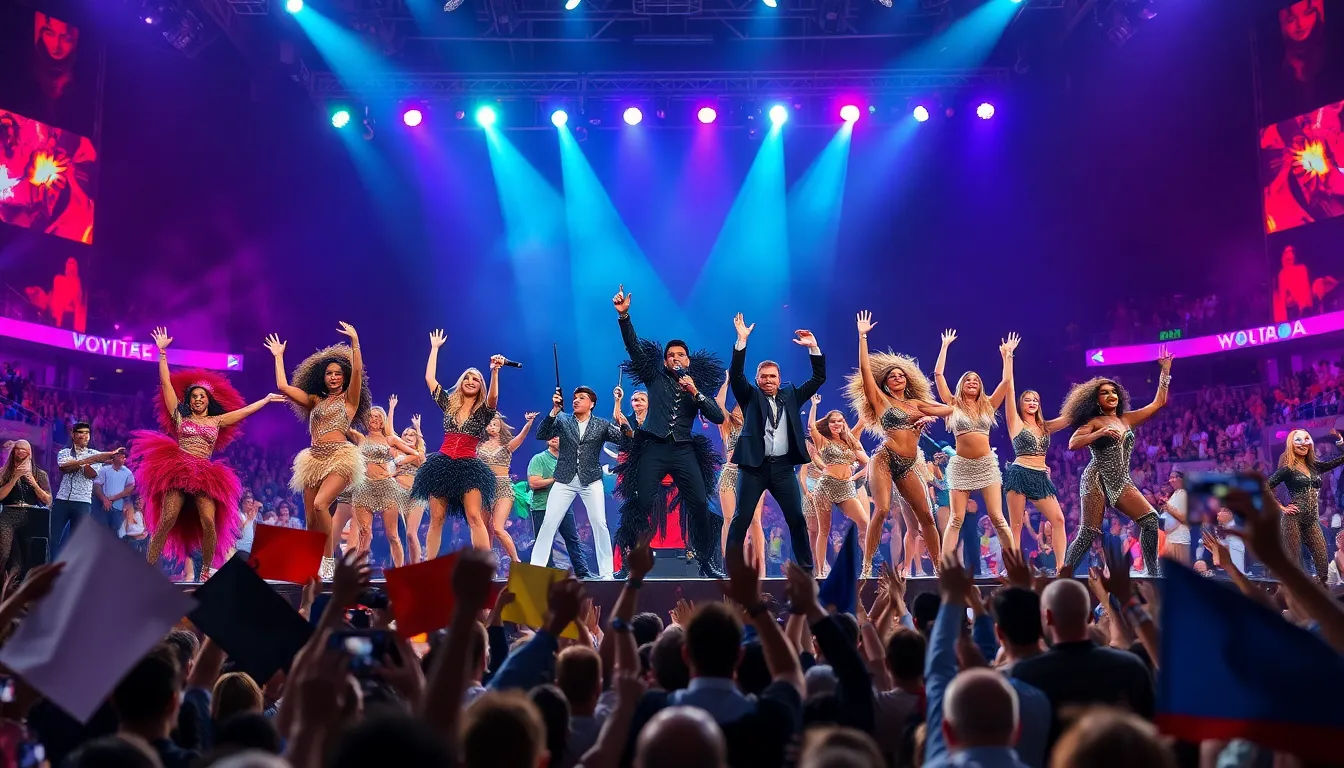The Super Bowl halftime show has evolved into one of the most anticipated events in entertainment, captivating millions of viewers around the world. Each year, fans eagerly await the spectacle that combines music, dance, and elaborate staging, making it a highlight of the big game. It’s not just a break from football; it’s a cultural phenomenon that showcases the biggest stars in the music industry.
As the clock ticks down to halftime, excitement builds. Fans discuss who will take the stage and what surprises await. From iconic performances to unforgettable collaborations, the halftime show never fails to deliver. Understanding the history and significance of this event offers a deeper appreciation for its role in Super Bowl Sunday, making it more than just a musical interlude.
Table of Contents
ToggleOverview of Super Bowl Half Time Show Time
The Super Bowl halftime show represents a pinnacle moment in entertainment, drawing in over 100 million viewers annually. This spectacle showcases top-tier musical talent across genres, offering a vivid performance that stands apart from the main sporting event. Each year, major artists and bands contribute their skills to create a memorable experience marked by stunning visuals and impressive choreography.
Historically, the halftime show began as a simple musical interlude featuring marching bands. Its transformation into a high-profile event took shape in the 1990s with artists like Michael Jackson and Madonna. This shift brought new creative elements, elevating the performance to an artistic spectacle.
The production process involves weeks of preparation, with elaborate sets and intricate choreography designed to impress viewers. In recent years, technology has played a crucial role in enhancing the show, incorporating advanced audio-visual effects and elaborate staging.
The show’s significance extends beyond entertainment, often addressing cultural themes or current social issues. Each performance aims to resonate with diverse audiences while highlighting the artistry of its performers. The Super Bowl halftime show continues to evolve, maintaining its status as a cultural highlight that celebrates music and performance on a grand scale.
Historical Evolution of the Half Time Show

The Super Bowl halftime show has transformed from a simple interlude into a cornerstone of global entertainment, engaging millions annually. Its evolution reflects changes in music, culture, and technology, marking significant moments in television history.
Early Years of the Super Bowl
The Super Bowl halftime show began in 1967 as a modest affair, featuring college marching bands and simple musical performances. The first show highlighted the University of Arizona and Grambling State University bands. The focus remained primarily on patriotic themes and local talent, reflecting the era’s cultural values. As the years progressed, variety acts emerged, including performers like Up with People during the 1970s. The shift from these simplistic performances laid the groundwork for future growth and expansion.
Iconic Performances Through the Decades
The 1990s marked a significant turning point, showcasing iconic performances that reshaped the halftime experience. In 1993, Michael Jackson set a new standard, captivating over 90 million viewers with a production that included elaborate choreography and a powerful message. Subsequent performances by artists such as Madonna in 2012 added visual spectacle and a blend of cultures, appealing to diverse audiences. The halftime show has featured a range of genres, from rock legends like Bruce Springsteen to pop sensations like Beyoncé, each contributing unique flair and talent. Events such as Shakira and Jennifer Lopez in 2020 and The Weeknd in 2021 demonstrated the show’s capacity for high-energy performances that often address social issues, reflecting the current cultural climate.
Popular Artist Features
The Super Bowl halftime show frequently features renowned artists who elevate the event’s status. These performers not only entertain but also shape cultural moments that resonate with diverse audiences.
Memorable Performers
Memorable performances define the Super Bowl halftime show. Here are several standout artists and their contributions:
- Michael Jackson: His 1993 performance redefined halftime shows with choreography and audience engagement.
- Madonna: Her 2012 show featured a powerful medley, incorporating themes of empowerment and reinvention.
- Beyoncé: Known for her dynamic stage presence, her 2013 performance included a reunion with Destiny’s Child.
- Shakira and Jennifer Lopez: Their 2020 performance celebrated Latin culture through vibrant visuals and energetic choreography.
- The Weeknd: Featuring a unique visual concept in 2021, he utilized innovative technology to enhance viewer engagement.
Trends in Artist Selection
Trends in artist selection reflect evolving audience preferences and cultural dynamics. Key trends include:
- Diversity: Selection increasingly emphasizes diverse genres, showcasing artists from various musical backgrounds, including pop, rock, and hip-hop.
- Cultural Representation: Integrating artists who represent significant cultural milestones or movements enhances relatability and engagement.
- Collaborative Performances: Many shows feature multiple artists, fostering collaboration that amplifies the experience.
- Legacy Artists: Iconic musicians frequently headline, capitalizing on their established fanbases and cultural relevance.
- Emerging Artists: The inclusion of rising stars highlights current music trends, appealing to younger viewers and expanding the audience demographic.
These trends and memorable performances contribute to the halftime show’s prestige, making it a vital part of Super Bowl Sunday for viewers globally.
Impact on Sports and Entertainment
The Super Bowl halftime show significantly influences the realms of sports and entertainment. It’s not merely an intermission; it shapes viewer engagement, drives economic impact, and showcases cultural movements.
Cultural Significance
The halftime show acts as a barometer for societal trends and cultural shifts. Performances often reflect contemporary social issues, allowing artists to convey powerful messages to a global audience. For instance, Shakira and Jennifer Lopez’s 2020 performance highlighted themes of empowerment and cultural pride, resonating with diverse communities. Additionally, the show’s evolving artist selection promotes inclusivity and representation, showcasing a variety of genres and backgrounds. This evolution reinforces the halftime show’s role as a cultural touchstone that reflects audience values and aspirations, enhancing its overall impact.
Economic Factors
The economic influence of the halftime show is substantial. Companies invest millions in advertising during this time, with 30-second commercial slots often commanding prices exceeding $5 million. This creates a lucrative platform for brands, eager to associate themselves with the event’s high viewership. Furthermore, successful halftime performances can lead to increased album sales and streaming numbers for featured artists, generating long-term revenue. The economic synergy between sports and entertainment solidifies the Super Bowl’s status as a premier event, contributing significantly to the overall financial ecosystem surrounding professional football.
Future of the Super Bowl Half Time Show Time
The future of the Super Bowl halftime show promises continued innovation and engagement. Emerging technologies, such as augmented reality (AR) and virtual reality (VR), are set to redefine audience experiences. These technologies can enhance visual storytelling and create immersive atmospheres, captivating viewers both in-stadium and at home.
Artist selection will likely remain a focal point, with a push for diverse representation across genres. The inclusion of both established icons and rising stars will reflect evolving cultural dynamics. Collaborations between artists can enhance performances, fostering unique interpretations of popular songs and drawing in a broader audience.
Cultural themes will increasingly influence the shows. Performances may address social issues or represent significant movements, appealing to the contemporary cultural landscape. This connection to societal trends can deepen viewer engagement and relevance.
Economic impacts will continue to shape the halftime show landscape. As brands seek visibility during the event, partnerships with artists may create lucrative opportunities for cross-promotion. Enhanced advertising strategies will likely emerge, leveraging the halftime show’s vast audience to maximize brand reach.
The Super Bowl halftime show’s global appeal will likely grow, attracting international artists and influences. This expansion can introduce new styles and rhythms, enriching the overall entertainment value. As the event evolves, it remains a pivotal cultural phenomenon that reflects both entertainment trends and societal shifts, ensuring its significance for years to come.
The Super Bowl halftime show stands as a testament to the intersection of sports and entertainment. Its evolution reflects changing cultural values and audience expectations. With each passing year, it captivates millions through stunning performances and powerful messages.
Looking ahead, the halftime show is poised for even greater innovation. Emerging technologies and a focus on diverse representation will likely enhance the viewing experience. As it continues to address contemporary themes and engage global audiences, the halftime show will remain a vital part of Super Bowl Sunday, solidifying its place in popular culture.


